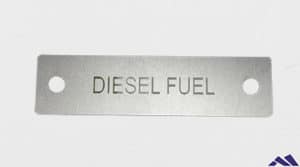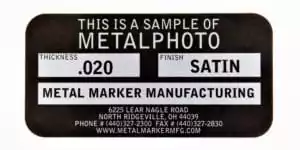Identification
Fuel tank identification tags are used to accurately label important information regarding the tank and the liquid fuel it houses.
The specific information provided on each tank varies by tank type, local guidelines, etc.
Some of the most commonly marked data includes:
– Type of fuel (Diesel, Regular, Etc.)
– How many gallons the tank holds
– Flammability
This information is used by workers, inspectors, and first responders in the event of an emergency.
Safety
Safety Regulation
Identification markers for this application are often required by federal or state guidelines.
The Uniform Fire Code (UFC) 79.109 sets standards in place for marking above-ground fuel tanks. Any tank storing flammable liquids in excess of 100 gallons must be properly labeled.
This can include flammable warning signs, caution markers, etc. These safety markers are incredibly vital for firefighters and first responders. If a nearby fire breaks out, they can quickly take the appropriate actions to maintain safety in the area.
Fuel tanks are typically adorned with a placard indicating flammability, chemical reactivity, level of health hazards, and special precautions. In addition, a number scale of 0 to 4 is used to communicate the level of risk. 0 being no risk, 4 being the highest risk level.
OSHA regulation may also come into play, depending on industry and the specific type of tank being marked.
Other Applications
Inspections
Identification is used for many additional resources as well. One of the main applications is for inspection. Like most industrial equipment, tanks are often inspected to make sure they are up to standard on all regulatory guidelines.
These markings can include the date of last inspection, serial number, or other pertinent info. Inspections ensure fuel tanks are safe, and prevent accidents before they occur. They also serve to document any issues, and fix any minor problems.
Ship/Boat Safety
Boats and ships require a great deal of identification and labeling. Every piece of equipment, tool, and panel needs to be marked. From military to private boats, these guidelines are all-encompassing.
Federal guidelines (33 CFR 183.514) mandate boat fuel tanks to be marked with certification for passing static pressure tests. This is just one of many federal and local regulations.
Durability
Fuel tanks are sometimes used in harsh industrial-type environments. These containers are exposed to chemicals, water, wear, and more. Above-ground tanks may remain outdoors, leaving them vulnerable to weather as well.
Generally, fuel tanks are heavily protected as they can be damaged or become dangerous if worn. Chemical exposure or wear could cause leaks, and nearby sparks from machinery or electrical wires could be a big problem.
While tanks are protected and built incredibly tough, the information on the tank needs to hold up as well. With industrial environments, anything can happen. You don’t want your identification to fade or become illegible.
Materials
Metal
Metal identification plates are one of the most popular choices for tank identification due to the level of durability they provide. Aluminum and stainless steel are typically the preferred options.

Anodized aluminum offers corrosion resistance, as well as the ability to add a solid color to the tag. This allows for color coding based on fuel type, safety warnings (i.e. red for fire hazard), or company branding.
Stainless steel is the go-to for max durability. These plates will often last as long as the tank itself. They feature full resistance to weathering, chemicals, and more. Stainless also provides the opportunity to directly weld the plate to the tank. This ensures a secure, permanent attachment.
Labels
There are some marking applications in which metal substrates aren’t ideal. For example, the tank might not have a flat surface for a metal nameplate to attach.
This is where labels come in to play. A poly/vinyl material base is printed with the custom design required. This material is not the most durable solution however. The labels will wear within just a few years if exposed to industrial environments.
A laminate cover can be applied for a bit more toughness, but these are still not truly permanent solutions.
If the highest level of durability in a label is necessary, Lexan material can be used. It is much more resilient to wear, however it is not on the same level as metal substrates.
Marking Processes
Photo Anodization
The photo anodization process is excellent for labeling nearly anything in an industrial environment.
When it comes to durability, the process really shines.

With 20+ years of outdoor durability, you can rest assured that your message will remain legible for a very long time.
With full customization, these nameplates can include as much or as little information as necessary.
Etching
Metal nameplates used for marking fuel tanks can also be custom etched. The etching process exposes the material to a laser or chemicals to imprint the desired information.
These slight indentations are easy to read, but lack in durability. With repeated abuse, these markings will fade from the material. The addition of a single color into the design is possible with this process, however the coloring is also highly susceptible to wear.
Digital Printing
When using polyester or vinyl based labels, there is no underlying material to embed information into. Instead, these markers are digitally printed with custom information.
This type of identification is often preferred for safety labels due to their full color capabilities. Labels can feature full color designs, including logos and other imaging. Safety labels can be produced with bright colors for stand-out messaging.
The drawback to this process is its lack of durability. The surface level printing will quickly be removed if exposed to heavy wear. Outdoor conditions will cause the ink to fade from UV exposure, and weathering will not help either.
As mentioned, laminates can be applied over the design to prolong its life span.
Wrap-Up
Fuel tanks are a vital piece of the industrial puzzle. They are relied upon to store the fuel that keeps machines and equipment running.
Due to the risk it presents, fuel storage requires safety labeling in order to ensure correct protocols are followed, and guidelines are adhered to.
This protects not only organizational assets and workers, but also the neighboring areas as well.